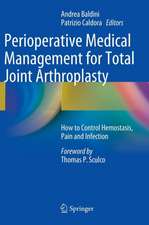HCV Infection and Cryoglobulinemia
Editat de Franco Dammaccoen Limba Engleză Paperback – 18 apr 2014
Preț: 737.76 lei
Preț vechi: 776.59 lei
-5% Nou
Puncte Express: 1107
Preț estimativ în valută:
141.17€ • 147.79$ • 116.81£
141.17€ • 147.79$ • 116.81£
Carte tipărită la comandă
Livrare economică 02-08 aprilie
Preluare comenzi: 021 569.72.76
Specificații
ISBN-13: 9788847055810
ISBN-10: 8847055814
Pagini: 380
Ilustrații: XVIII, 362 p.
Dimensiuni: 193 x 260 x 20 mm
Greutate: 0.79 kg
Ediția:2012
Editura: Springer
Colecția Springer
Locul publicării:Milano, Italy
ISBN-10: 8847055814
Pagini: 380
Ilustrații: XVIII, 362 p.
Dimensiuni: 193 x 260 x 20 mm
Greutate: 0.79 kg
Ediția:2012
Editura: Springer
Colecția Springer
Locul publicării:Milano, Italy
Public țintă
Professional/practitionerCuprins
Hepatitis C virus infection and the role of the immune system.- Cryoglobulinemia: immunochemical characterization, serological abnormalities and histopathological changes.- Structural and genetic features, cytokines and chemokines in cryoglobulinemia.- Cellular compartments of HCV infection (and replication) - Mechanism(s) of cryoprecipitation.- Clinical manifestations of cryoglobulinemia.- HCV infection, cryoglobulinemia and non-Hodgkin’s lymphomas.- Therapy of cryoglobulinemia.
Textul de pe ultima copertă
In 1947, Lerner and Watson showed that the cold-precipitable proteins in serum were gammaglobulins. These “cryoglobulins” were responsible for the corresponding clinical condition “cryoglobulinemia.” Meltzer and Franklin, in 1966, provided an accurate description of the typical clinical symptoms associated with cryoglobulinemia. Subsequent progress in this field was rather slow until the end of the 1980s, when cryoglobulinemia was definitively shown to be an extrahepatic manifestation of hepatitis C virus infection.
The book is unique in its detailed presentation and fundamental approach. Highly qualified authors have contributed critical articles reviewing significant developments in our understanding of and therapeutic approach to HCV infection and cryoglobulinemia. The text is accompanied by striking color images and illustrations and highly informative tables.
This comprehensive review of a systemic disease with a complex etiology is a valuable source of up-to-date,expert information not only for basic scientists and specialists in several disciplines but also for general practitioners as well as graduate and post-graduate students in clinical and medical research.
The book is unique in its detailed presentation and fundamental approach. Highly qualified authors have contributed critical articles reviewing significant developments in our understanding of and therapeutic approach to HCV infection and cryoglobulinemia. The text is accompanied by striking color images and illustrations and highly informative tables.
This comprehensive review of a systemic disease with a complex etiology is a valuable source of up-to-date,expert information not only for basic scientists and specialists in several disciplines but also for general practitioners as well as graduate and post-graduate students in clinical and medical research.
Caracteristici
Comprehensive review of cryoglobulinemia, for scientists and specialists involved in several disciplines, including internal medicine, hepatology, hematology, oncology, infectious diseases, rheumatology, nephrology and dermatology Immediacy of style, striking illustrations, and color plates Irreplaceable source of update for general practitioners, graduate and post-graduate students









